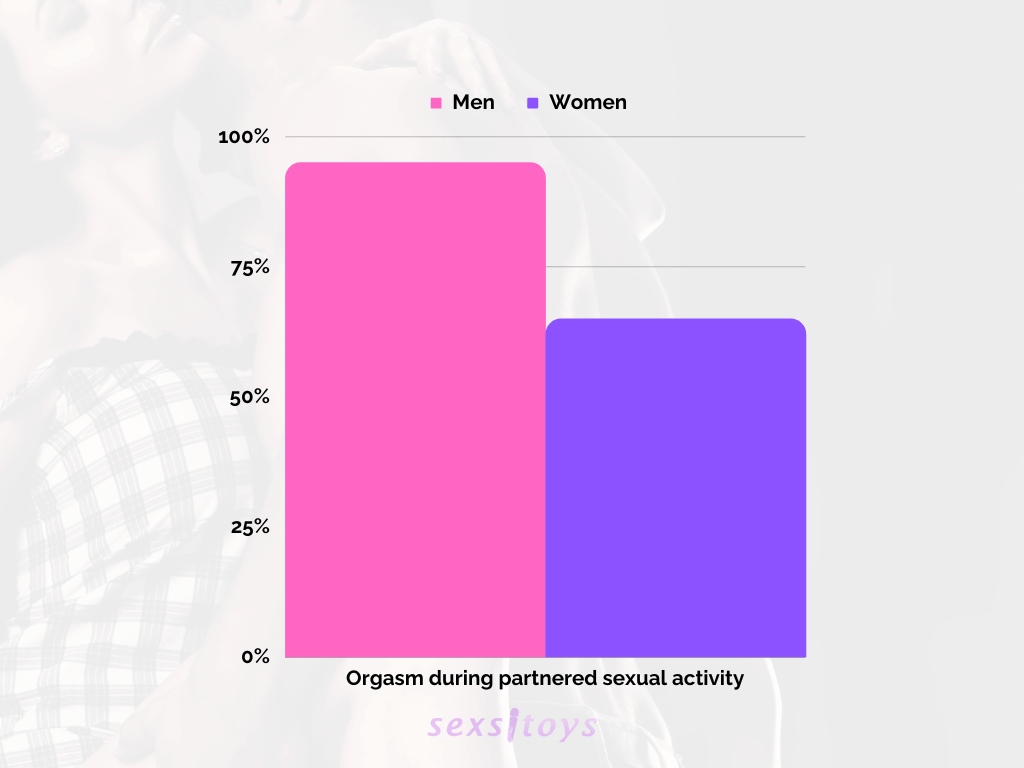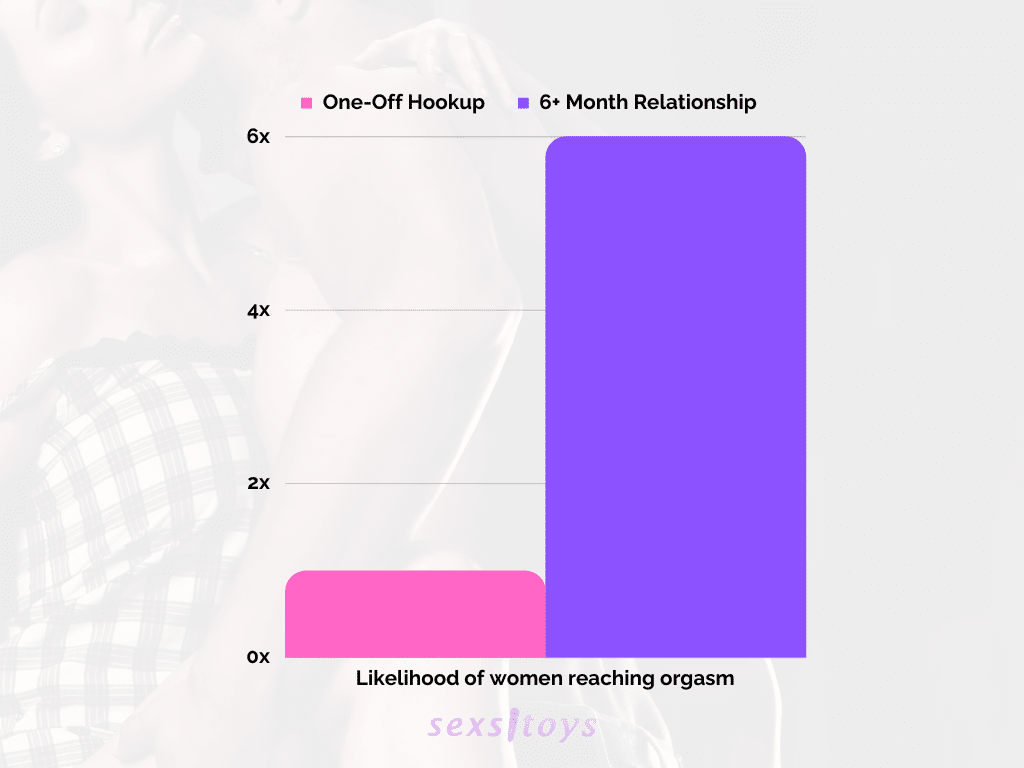
Orgasm statistics – a topic that intersects science, wellness, and human experience.
If you’re a journalist looking for compelling data, a researcher in search of in-depth analysis, or simply a curious mind eager to find out some cool orgasm stats, the researchers at Sexsi Toys have you covered.
Our sex researchers have curated a list of interesting and insightful orgasm statistics gathered from a range of academic research studies.
Continue below.
Top Orgasm Statistics You Should Know in 2023
Here are some exciting statistics about climaxing that will blow your minds –
- 81.6% of women report that they do not orgasm solely from sexual intercourse – they would need additional clitoris stimulation to get ultimate pleasure. Only a handful of women (18.4%) report that they achieve orgasm only through intercourse. [Source]
- Around 50% of women have reported experiencing their first orgasm after the age of 20. [Source]
- 34% of women say exclusive clitoral stimulation is the most vital factor making them orgasm. [Source]
- 5-10% of women have reported that they never orgasmed [Source]
- 59% of women have faked an orgasm. [Source]
============================
Jump to more data:
Gender Gap in Orgasms Statistics: Men Are 30% More Likely to Orgasm Than Women (95% vs 65%)

95% of heterosexual men usually or always orgasm during partnered sexual activity compared to just 65% of heterosexual women.
[Reference: Archives of Sexual Behavior]
The data from the Archives of Sexual Behavior exposes a glaring discrepancy between heterosexual men and women when it comes to experiencing orgasms during partnered sexual activities.
This isn’t just a one-off finding; other studies have shown similar trends. The reasons for this gap are multifaceted, ranging from societal attitudes that prioritize male pleasure to lack of comprehensive sexual education that also focuses on female pleasure.
Why do men orgasm more often than women?
The higher frequency of male orgasms is influenced by a combination of biological, psychological, and sociocultural factors. For instance, the physical mechanics of male arousal are often better understood, and society has long placed greater emphasis on male sexual pleasure. This extends to the way sexual education is often taught, which can be male-centric.
What is the orgasm gap?
The orgasm gap refers to the observed discrepancy in orgasm frequency between genders, particularly in heterosexual relationships. This issue has roots not only in biological differences but also in social norms and educational shortcomings that don’t fully address female sexual satisfaction.
How often do men vs women orgasm during sex?
While the Archives of Sexual Behavior highlights a specific statistical gap, other research corroborates the trend. It’s estimated that heterosexual men orgasm at a much higher frequency compared to their female counterparts. This calls for further investigation and educational initiatives that cater to the sexual well-being of both genders.
Gender differences in sexual satisfaction statistics
Data across various studies consistently show that women report lower rates of sexual satisfaction compared to men.
Apart from orgasm frequency, this also extends to other aspects like emotional connection and fulfillment during sexual encounters. The pressing question remains: how can educational programs adapt to bridge this gender gap in sexual well-being?
Relationship Status and Orgasm Likelihood Statistics: Love and Orgasms, A Direct Correlation

Women in a relationship of 6+ months are more than 6 times as likely to orgasm during a sexual encounter than a woman with a first-time hookup – That’s a 500% increase!
[Reference: American Sociological Review]
According to a study published in the American Sociological Review, women in a relationship lasting six months or more are over six times (500%) more likely to orgasm during sexual encounters compared to women engaged in a first-time hookup.
This statistic emphasizes how emotional connection and familiarity are significant factors in sexual satisfaction for many women.
As couples become more comfortable with each other and better communicators, the likelihood of female orgasms increases.
Additional Info
Does relationship length affect orgasm frequency?
Yes, relationship length does appear to have an impact on orgasm frequency, particularly for women.
Emotional intimacy and familiarity in long-term relationships lead to improved communication about sexual preferences, which in turn boosts the chances of female orgasms, as evidenced by the study in the American Sociological Review.
How does being in a relationship impact sexual satisfaction?
Being in a long-term relationship significantly enhances sexual satisfaction for both parties, but particularly for women.
Beyond the physical act, emotional bonds and mutual understanding results in a more fulfilling sexual experience.
The study suggests that the comfort level and communication skills developed over time leads to more satisfying sexual encounters.
Statistics on orgasms in long-term relationships vs hookups
Research indicates that women in long-term relationships are far more likely to achieve orgasms compared to one-time hookups.
According to the American Sociological Review, the likelihood increases more than sixfold.
This is in line with other research that suggests long-term relationships foster an environment where sexual satisfaction is more mutual.
Impact of relationship status on female orgasms
Relationship status has a substantial impact on the frequency of female orgasms.
Casual encounters or first-time hookups lack the emotional intimacy and mutual understanding that contribute to female sexual satisfaction.
In contrast, long-term relationships provide a space for more open communication and understanding, which directly impacts the likelihood of a woman experiencing an orgasm.
Apart from orgasm frequency, this also extends to other aspects like emotional connection and fulfillment during sexual encounters. The pressing question remains: how can educational programs adapt to bridge this gender gap in sexual well-being?
Pre-orgasmia and Anorgasmia Statistics – The Silent Percentage of Women Who’ve Never Experienced an Orgasm
5-10% of women have never orgasmed, though many of these women may later in life.
[Reference: Journal of Sex and Marital Therapy]
In an eye-opening statistic, the Journal of Sex and Marital Therapy reveals that between 5-10% of women have yet to experience an orgasm, though this may change as they advance in age. This percentage underscores the need to upgrade our sexual education and healthcare services to address this silent fraction of women who are possibly left out in our current system.
What percentage of women have never had an orgasm?
Current research suggests that between 5% to 10% of women have never experienced an orgasm, according to a study published in the Journal of Sex and Marital Therapy. However, it is important to note that this ability may take time and can change with age, varying individual factors, and exposure to sexual health resources.
Causes of anorgasmia in women
As a multifaceted condition, anorgasmia in women can be attributed to a variety of causes including physical issues like diabetes, neurological disorders, hormonal imbalances or gynaecological operations. Other causes might be psychological factors such as stress, anxiety, depression, history of sexual abuse, or cultural or religious beliefs about sex. Moreover, certain medications, like antidepressants, can also significantly impact orgasmic ability.
How common is it for women to never orgasm?
The inability to orgasm, medically termed as anorgasmia, is a common sexual issue amongst women. It’s estimated that 5 to 10% of women have never experienced an orgasm. However, this figure is likely higher as many cases probably go unreported due to stigma or lack of understanding about the condition.
Statistics on women who have never orgasmed
Data from the Journal of Sex and Marital Therapy states that between 5-10% of women have never orgasmed, pointing to an issue that quite possibly remains underrepresented in sexual health conversations and studies. This information signals the critical need for comprehensive sex education efforts and a more holistic approach to women’s sexual healthcare.
Multiple Orgasms Statistics – A Look at Women and Multiple Orgasms.
Stat: 43% of women have experienced multiple orgasms.
[Reference: Archives of Sexual Behavior]
A compelling 43% of women have reported experiencing multiple orgasms, according to a study published in the Archives of Sexual Behavior. This statistic presents an exciting point of conversation in discussions of women’s varied sexual experiences, highlighting the impact of both internal and external stimulation in achieving multiple orgasms.
How common are multiple orgasms in women?
Significantly common. Of all women, 43% have reported experiencing multiple orgasms, pointing to it being a common occurrence rather than a rarity. This underscores the complex nature of women’s sexuality and the potential for diverse sexual experiences.
Statistics on women experiencing multiple orgasms
While orgasms vary greatly from woman to woman, a study in the Archives of Sexual Behavior has presented some intriguing numbers. Precisely, 43% of women explored in this research recounted having multiple orgasms, emphasizing that this is no uncommon occurrence.
What percentage of women have multiple orgasms?
The answer is 43%. This figure, drawn from research in the Archives of Sexual Behavior, indicates that almost half of the female population experiences multiple orgasms, spotlighting the breadth and variety of women’s sexual sensations.
Factors contributing to multiple orgasms in women
Multiple factors contribute to women experiencing multiple orgasms. This can include physical aspects such as the sensitivity of the clitoris and the response to internal stimulation, as well as psychological factors such as mental arousal, comfort, and lack of stress. A woman’s overall health, her relationship with her partner, and the adequacy of foreplay also influence the potential for multiple orgasms.
Fake Orgasm Statistics – The Truth About Fake Orgasms
59% of women have faked an orgasm.
[Reference: Archives of Sexual Behavior]
According to a study published in the Archives of Sexual Behavior, a staggering 59% of women confess to having faked an orgasm at some point. This fact doesn’t just reveal a bedroom falsehood, it also opens the door to important discussions about honesty, authenticity, and open communication in intimate relationships.
How often do women fake orgasms?
While it’s hard to quantify precisely the frequency at which women fake orgasms, research suggests it’s not uncommon.
As mentioned, 59% of women report having faked an orgasm on at least one occasion. This suggests that almost 6 in 10 women could have potentially found themselves in a situation where they felt the need to feign orgasmic satisfaction.
Why do women fake orgasms?
Women may fake orgasms for several reasons. A study from the University of Kansas identified primary motives as being doing so out of love for their partner, or not wanting to hurt their partner’s feelings.
Other reasons include wanting to end sex when feeling uncomfortable or unaroused, or even due to societal pressures which sometimes position sexual pleasure as predominantly male-biased.
Statistics on fake orgasms in women
The reality behind the count of fake orgasms may be alarming. The previously mentioned(59%) figure is not the only one to come out of research.
A study by Temple University found that up to 60% of college women reported masturbating to orgasm but did not orgasm during intercourse. More comprehensive research involves expanding the geographic and demographic reach of these studies.
Psychological Reasons behind faking orgasms
Psychologically, the act of faking orgasms could be attributable to a variety of factors. Women may feel social pressure to meet certain perceived sexual expectations, including reaching climax during sex. Fear of intimacy, lack of sexual satisfaction, or even anxiety regarding sexual performance can also play a part. This underscores how essential open, honest communication is within sexual relationships to achieve mutual satisfaction.
Orgasm Timing Statistics – How Long Does It Take to Reach the Big O?
Men take 5.4 minutes on average to orgasm, while women take an average of 14 minutes during partnered sex.
[Reference: Journal of Sexual Medicine]
Men take an average of 5.4 minutes to reach orgasm while women require more time, averaging about 14 minutes during partnered sex according to a study published in the Journal of Sexual Medicine.
With these statistics, we could view the dynamics of pacing and understanding during sexual encounters in a new light.
Mutual understanding regarding orgasm times can help minimize anxieties and fear prevalent in men about premature ejaculation and other performance-related issues.
Average time it takes for men and women to orgasm
On average, men achieve orgasm significantly faster than women during sexual interactions. It typically takes a male only 5.4 minutes to climax while a female would need around 14 minutes of sexual stimulation.
How long does it take for a woman to orgasm?
The length of time it takes for a woman to reach orgasm varies from individual to individual, but on average, it takes a woman about 14 minutes to achieve orgasm during partnered sex. However, the duration can be influenced by a variety of factors, including the intensity and type of sexual stimulation, emotional connection, and comfort level among others.
Statistics on time to orgasm in men vs women
In a side-by-side comparison of orgasm timings, men are much quicker. The average times reveal a contrast in male and female sexual response patterns. While men typically take around 5.4 minutes to climax, women need approximately 14 minutes to reach the same threshold.
Factors affecting orgasm timing in men and women
There are many factors affecting orgasm timing for both men and women. In men, anxiety or fear, especially about premature ejaculation, can affect timing. For women, the time can be influenced by factors such as the type and duration of sexual stimulation, emotional intimacy or mental state, and even the sexual position. Additionally, both genders may experience variations in orgasm timings with age, health status, stress levels, medications, and many other individual differences.
Marijuana and Orgasm Statistics – High on Pleasure: Cannabis and Its Impact on Orgasms
Over 70% of both men and women say their orgasms are more intense when using cannabis.
[Reference: Journal of Sexual Medicine]
High on pleasure, indeed! A staggering 70% of both men and women claim that their orgasms are more intensely pleasurable when under the influence of cannabis, as per a study conducted by the Journal of Sexual Medicine.
Does marijuana enhance orgasms?
Yes, as per the aforementioned statistic, the majority of cannabis users report enhanced orgasms. It’s suggested that cannabis might boost the sensations of physical touch, lowering inhibitions and increasing overall sensitivity which could contribute to this reported enhancement.
Impact of Cannabis on Sexual Satisfaction
The research suggests that cannabis positively impacts sexual satisfaction. It does so not only by intensifying orgasms but also by increasing arousal and reducing anxiety associated with sexual encounters. However, it’s worth mentioning that experiences might vary depending on individual tolerance, dosage consumed, and the strain of cannabis used.
Statistics on Marijuana Use and Orgasms
The study from the Journal of Sexual Medicine evidences more than half of male and female respondents attributing an increase in orgasm intensity to cannabis use. Additional studies will help corroborate these findings and potentially shed light on how consistently cannabis has this effect across differing demographics and usage scenarios.
How does Cannabis Affect Orgasm Intensity?
While scientific understanding isn’t definitive yet, the Journal of Sexual Medicine study suggests that cannabis may increase sensitivity during sex, which can potentially make orgasms feel more intense.
Cannabis has been documented to slow the perception of time and increase physical awareness, potentially contributing to the perception of expanded enjoyment.
Orgasm and Prostate Health Statistics – Ejaculation and Prostate Health: What the Data Says
Studies show a statistically significant relationship between higher ejaculation frequency and lower risk of prostate cancer in men.
[Reference: European Urology]
According to recent studies published in European Urology, a strong statistical relationship exists between a higher ejaculation frequency and a reduced risk of prostate cancer in men. This data is incredibly significant, spinning a new perspective on the health benefits of regular sexual activity, specifically for men.
Does frequent ejaculation reduce prostate cancer risk?
In alignment with the European Urology findings, consistent ejaculation can indeed lower the likelihood of developing prostate cancer. Frequent ejaculation, whether it’s achieved through sexual intercourse, masturbation, or wet dreams, may aid in the expulsion of harmful substances from the prostate.
Health benefits of orgasms for men
Orgasms, independent of their source, impart numerous health benefits for men beyond reduced prostate cancer risk. They are linked with improved mood and sleep quality, reduced stress levels, enhanced cardiovascular health, and reinforced immune system functionality. Additionally, orgasms can improve partner intimacy and personal well-being.
Statistics on ejaculation frequency and prostate health
Data indicated that men in their 20s who ejaculated 21 or more times a month saw a 19% lower risk of prostate cancer compared to those who ejaculated less frequently. In older men—from their 40s onwards—who maintained a high ejaculation frequency, the risk drop was even more pronounced at 22%.
Correlation between orgasms and prostate cancer risk
As established by the aforementioned European Urology study, there is a distinct inverse correlation between orgasm frequency and prostate cancer risk. With increased ejaculation, the likelihood of prostate cancer reduces, leveraging the health merits of consistent sexual activity. However, it’s critical to note that a sexually active lifestyle alone can’t guarantee immunity against prostate cancer. It is one of many lifestyle factors that, in combination, can contribute to a decreased risk.
============================
Sexual Orientation Orgasm Statistics
The rate of orgasm in men and women is affected by their sexual orientations. Here are some of the key orgasm statistics for different genders:
- 95% of heterosexual men mostly orgasm during sexual intercourse as compared to only 65% of heterosexual women. [Source]
- Sexual orientation is less likely to affect orgasm rates in men than in women. 95% of heterosexual men, 88% of bisexual men, and 89% of gay men mostly orgasm during partnered intercourse. On the other hand, 86% of homosexual women mostly orgasm during intercourse as compared to only 65% of heterosexual women and 66% of bisexual women. [Source]
- Over 10-40% of women state they have difficulties reaching orgasm or they are unable to reach orgasm [Source]. Hence, if you are unable to hit your climax, then the problem is more common than you think. Difficulty in arousal, age, and use of lubricants are some of the common reasons why women cannot orgasm in many cases.
Does Relationship Status Affect Orgasm Rates?
It isn’t surprising that orgasm rates are higher when you are familiar with the person you are having sex with. Here are some key facts to know:
- Women who are in a relationship for more than 6 months are 6x more likely to hit the climax as compared to a woman who is having a sexual encounter for the first time. [Source]
Additionally, having a sexual encounter with a partner for the third or fifth time is more likely to lead to orgasm than their first hookup. The orgasm rate doubles when hooking up more than six times.
Orgasm Gap: Does it Still Exist?
The orgasm gap describes the disparity that exists between a man and a woman when they indulge in a sexual relationship. Unsurprisingly, the orgasm gap exists because scientific research has found a significant difference between the orgasm rate of men and women in heterosexual relationships.
Here are some striking orgasm statistics that highlight these gaps:
- 3 out of 4 heterosexual women acknowledge that they cannot hit the climax during a sexual encounter with their partners. In fact, 20% of women report that they do not orgasm. On the other hand, this percentage is as low as 2% for men. [Source]
- 30% of men think that penetration is the best way to make a woman orgasm; however, over 50% of women stated that clitoral stimulation offers them ultimate pleasure.
- 30% of women and 25% of men are unable to find the clitoris – one of the primary causes of reaching orgasm in women.
- On average, men take approximately 5.4 minutes to reach the point of orgasm [Source] while it may last from 10-30 seconds. [Source]
- 25.2% of women take approximately 2-3 minutes to hit the climax when they orgasm alone or with sex toys. [Source]
- On average, 33.4% of women orgasm 3 times during partnered sex or when playing solo. [Source]
- In most cases, female orgasms last longer than men, averaging 13-50 seconds or even more. [Source]
Who Never Had an Orgasm
When it comes to having fun while orgasming and faking it, the differences between men and women are quite evident.
- 12% of women report achieving orgasm 10 times during a single encounter of partnered intercourse or solo play. [Source]
- Less than 10% of men in the age group of 20’s orgasm multiple times, while the percentage is less than 7% for men over their 30’s
5-10% of women report that they have never achieved orgasm [Source]. However, this number includes pre-orgasmic women (who may not have an orgasm yet but will later) and anorgasmic women (those who cannot orgasm).
Faking an Orgasm Statistics
Conclusion
Knowing these orgasm statistics can help you better understand your pleasures and boost your sex life.











